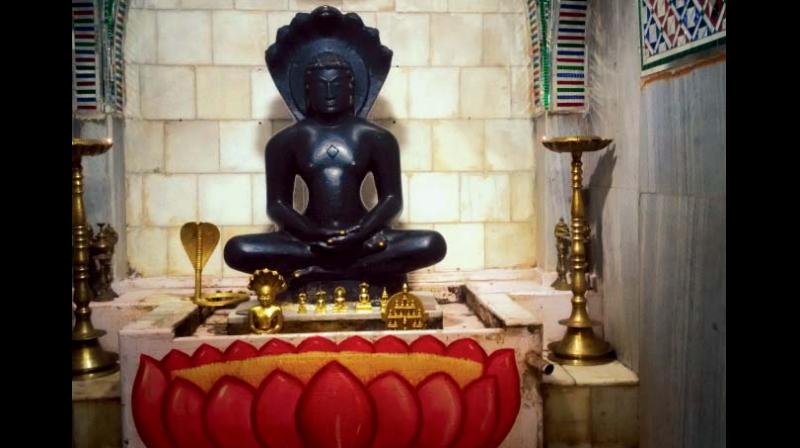Sunday Story: Kamthana, where tranquillity keeps the world's troubles at bay

A detached way of life, abstention from materialistic pleasure and an ascetic mindset- these are virtues which may hardly make sense in a 'maximum age' where food, fun and wealth are the ultimate joys. What then moved the Jain munis and Shravaks, several centuries ago, to reject all that their bodies demanded and tread the path of salvation? Kamthana- meaning a place for forgiveness-situated 10 km from Bidar town, could provide a few answers to the inquisitive mind, searching for answers to the eternal questions concerning immortality, truth and life. K.N. Reddy visited this village, famous for the historic Parshvanath Tirthankara Jain Temple, where the Jain muni found the perfect place to delve undisturbed into his inner mind to come up with answers which explained all.
Today due to neglect, the Parshvanath Temple, dedicated to the 23rd Jain Thirthankara (Mahavira was the 24th), is deserted for most part of the year except when nearby schools and colleges conduct NSS camps and other programmes.
In February, the shrine bustles with activity-it draws a large number of devotees from Karnataka, Telangana and Maharashtra for this is the time when the annual three-day car festival is held. Besides sermons, cultural and religious programmes are also held during the festival.
The sprawling premises and the serene atmosphere at the temple, which has facilities to accommodate devotees and host programmes, become a major attraction for the few who seek peace away from the hustle and bustle of urban life.
Bidar has strong connections with all religions-Besides Hinduism, Islam and Sikhism, the district was also famous for Jainism during the ancient and medieval period which is evident from the unique Jain Mandir at Kamthana.
According to inscriptions dating back to 753 AD, Rashtrakuta prince Dantidurga who proclaimed himself the sovereign power and made Manyakheta-the present-day Malkhed in Sedam taluk his capital, built the temple.
Nishidhis (stone inscriptions) indicate that like the famous Shravanabelagola and Koppal, the Jain munis and Shravaks chose this place to seek salvation through sallekhana, which is the religious practice of voluntarily fasting to death by gradually reducing the intake of food and liquids. A number of Nishidhis, which record the act of sallekhana, can be found in and around Kamthana.
The place also reveals the influence of Jain traditions prevalent in North India, evident from the presence of the 'Srivatsa' mark on the chest of Parshvanath. 'Srivatsa,' a diamond-shaped mark on the chest of Parshvanath, is usually found on sculptures in North India but not in South India. The mark is symbolic of the greatness of the soul, much like the diamond, known for its firmness, brightness and purity.
The mesmerising Parshvanath Tirthankara idol, which is about 115 cm tall and 55 cm wide in the Paryankasana style, is sheltered under a seven hooded serpent. Carved in black-blue granite, the statue is said to have been installed about 900 years ago.
Though the name of the sculptor who created such a marvellous piece of poetry in stone, remains unknown, the inscription in Kannada, found at the bottom of the sculpture, states that it was installed by Rechisetty of the Sri Mollasangha tradition.
This is the 18th Jain inscription found in Bidar, according to history professor Appanna Hanje, who has written a research article on the Kamthana Jain shrine. Created during the reign of the Kalyani Chalukyas in the 11th-12th century, the sculpture was installed in the cellar of the temple to keep it safe from aggressors. It was rediscovered by Acharya Shruta Sagar Muni in 1987 and the idol was brought out from the cellar and installed on a higher platform in the temple.
The famed shrine was also said to be part of a gurukul. For centuries, it provided students with religious and secular education. During the rule of the Nizam of Hyderabad, the gurukul and the temple were neglected for a century and even vandalised when some people tried to forcibly occupy temple land during the time of the Razaakars.
It was Jain Muni Sri Shruta Sagar, who worked on renovating the temple and began the tradition of organising the annual rath yatra, says Mr Vijaykumar Jain, Secretary of the Bidar Jain Milan. Though the Jain Milan has built around a dozen rooms, and also a community hall with donations given by devotees, its plans to revive the gurukul have so far remained on paper.
There are times when every human seeks peace from the troubles he finds himself in, when the craving for solitude and the disdain for the little joys of life, makes him turn to hallowed sites like Kamthana. Like many other forgotten but invaluable relics of our religions, this Jain centre too should have got much more attention than it has drawn.
For as the years and the centuries roll by, and the mind is subdued by the power of technology, places like Kamthana are sure to remind us of an age when lofty thoughts and ideals were all that mattered, when the mind held its own even as the world fell apart.

